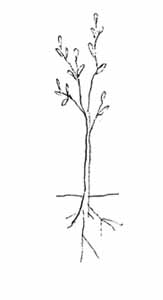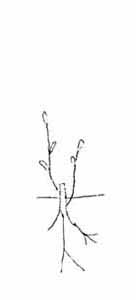Willow cutting exposed to reveal roots. The cutting is the basic unit of most Soil Bioengineering techniques. Once it is understood, there are many uses, combinations, and variations possible. These are discussed in the techniques section.
Physiology
The basic unit of most Soil Bioengineering techniques is a woody stem cutting. The diameter, length, number used, and manner of placement vary from practice to practice, however the basic physiology involved remains the same.
Growth regulating hormones are produced at the growing ends of plants at shoots and at root tips. In the shoots IAA is produced which promotes root growth, and and discourages suckers. At root tips, Cytokinins are produced which promote shoot growth, and discourage root growth. The series of figures below illustrate what is going on physiologically within a cutting.
_______

________1) Undisturbed woody plant__________2) Coppiced woody plant
The undisturbed plant in the first figure essentially has levels of IAA and Cytokinins more or less in balance as it grows. An excess of one stimulates growth of tissues that produce the other until equilibrium is reestablished.
The second figure shows the same plant after the top has been cut off. Now Cytokinins which are stimulating shoot growth are not being canceled out by IAA, which discourages such growth. The Cytokinins accumulate until they stimulate dormant buds to flush and growth resumes. A plant which has been cut like this and started to grow again is refered to as plant which has been coppiced.
Continued: Making cuttings

